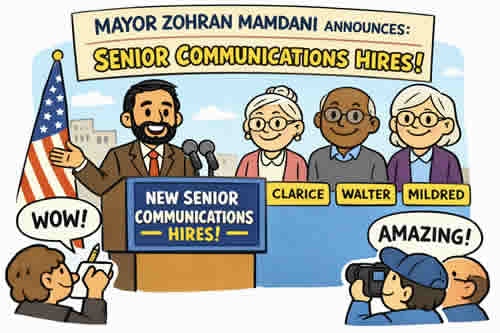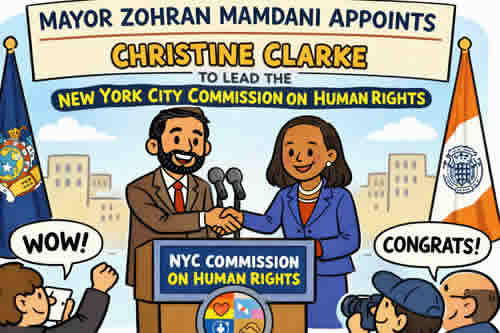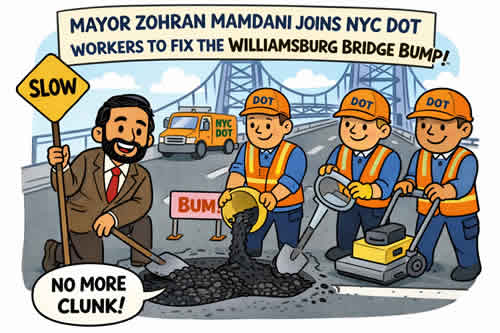Deputy Mayor Anne Williams-Isom, Health and Human Services: Good afternoon, everyone. I’m Anne Williams-Isom. I’m the deputy mayor for Health and Human Services. For this week’s asylum seeker briefing, we will discuss the efforts that the city is taking to assist school-aged children and young people through the public school system as we prepare for the start of the new school year. I’m excited to be joined today by New York City’s Public School Chancellor David Banks and his colleague Melissa Ramos. First, let me start by saying that every child, regardless of their immigration status, has the right to a good education. This issue fills my heart with joy, not just because I’m a parent of three children who I raised here in New York City, but also because I spent many years as the CEO of the Harlem Children’s Zone helping to uplift children and their families. And actually, that’s where I think, Chancellor, we met when I was working at Harlem Children’s Zone, and you would always call me when you would see the Harlem Children’s Zone kids on 125th Street doing things that they shouldn’t be doing.
Chancellor David Banks, Department of Education: They were out there all the time.
Deputy Mayor Williams-Isom: I know. And for our newest neighbors here in the city that are seeking asylum, we are working every day to give them a chance at independence. For children, that means enrolling them in school and providing the education and language access they need. For the adults, that means a pathway to work and to be able to support themselves and their families. With that said, I will now turn it over to Chancellor Banks to discuss our plans for the upcoming school year and what we are doing through the public school system to support the thousands of children who have arrived as part of the families seeking asylum. Chancellor.
Chancellor Banks: Thank you so much, Deputy Mayor Williams-Isom. I appreciate your friendship as well as your leadership here for the city. And good afternoon to everyone. Hope everybody had a great summer. As we stand here today, our focus remains undeterred on the education, the wellbeing, and the holistic development of every student that steps into a New York City Public School, regardless of where they come from or the language that they speak at home. So New York City has long been a beacon of hope and opportunity for countless individuals and their families. Since July of 2022, nearly 19,000 students in temporary housing have enrolled in our schools across all five boroughs. These numbers not only signify the vastness of our great city, but also the trust and faith that these families place in us.
In line with our commitment as a sanctuary city, we have steadfastly refrained from asking for any immigration status or country of origin when enrolling our students. We understand that every child has a right to an education and this belief is at the core of our values as New Yorkers and as Americans. To support our newcomer students, many of you will recall that we launched Project Open Arms. And this isn’t just a program, but it’s a commitment to ensure that no child feels left out or unsupported in our school system. From helping with school enrollment to offering access to crucial mental health supports, facilitating transportation to and from school and to ensuring that the transition of our English language learners is smooth.
Project Open Arms has been absolutely instrumental in the success that we have had to date. And I want to just recognize my chief of staff, Melissa Aviles-Ramos, who’s joined us here today. Melissa is the person who has been our asylum seeker czar for New York City Public Schools. She has driven the work, she has managed the teams from day one, and we have been at a very great place because of her leadership on this effort. We boast over 3,400 English as a New Language licensed teachers. I want to say that once again, we have over 3,400 English as a New Language licensed teachers and more than 1,700 certified bilingual teachers who are fluent in Spanish. Additionally, to bridge any communication gaps, we provide translation services to assist our families and caregivers.
Understanding the unique needs of our schools, especially those experiencing an influx of new students, we released a School Allocation Memorandum last fall. This emergency measure ensured that schools were financially equipped to accommodate their growing student population. Beyond the standard Fair Student Funding allocation, we committed an additional $110 million to address immediate requirements for all of our schools. This year, we completely changed our school funding formula to provide additional funding to schools based on the number of students in temporary housing that they enroll. We recognize that this specific student population faces additional challenges and that their schools need the additional resources to fully support them. And our promise doesn’t end there. So throughout the fall, we will keep in close coordination with principals and superintendents who see our newest New Yorkers join their school communities and we will disperse funds as necessary throughout the year. The success of New York City Public Schools during this crisis is not ours alone. It is the result of tight inter-agency coordination with our partners here at City Hall playing a critical role, bringing every stakeholder together.
So in conclusion, I want every parent, every caregiver and every student to know that the New York City Public Schools are here for you regardless of where your journey began. We are committed to ensuring it progresses with strength, knowledge, love and unwavering support. I want to thank all the parents, the families, the school principals, the students themselves who are in our schools across the city, who have welcomed, literally with open arms, these are wonderful, brilliant, beautiful young people who have gone through so much to come here to New York to try to participate in the American Dream. And we’re going to do everything that we possibly can do to provide as great a level of support as we can. So with that, I’ll wrap.
Deputy Mayor Williams-Isom: I was remembering the Zoom that you had with some of the principals early on where some of them were actually crying because they wanted to do more and they wanted to have more volunteer opportunities. But it’s just such a beautiful group of people that you work with. And so thank you for all that your principals are doing on behalf of the migrant children.
Chancellor Banks: And I want to thank you for that. And I want to just, again, salute them. They are the heroes in these places and spaces. Our parent coordinators, the work that they have done, they have raised money in their individual schools, they’ve done food drives, clothing drives. They’ve really wrapped their arms to ensure that all of the kids are really going to be good. And for that, I’m just eternally grateful to all of them.
Deputy Mayor Williams-Isom: Thank you so much, Chancellor Banks. Again, let me put a finer point on what the chancellor just said. We are ensuring access to programs to support the mental health for newly arrived students. We are making sure that they have the language access that they need and we’re helping them to transition to their new school environments. Put simply, we are giving every child a chance to flourish and to grow. Our schools offer kids not only access to education, but connect them to the support systems that includes peers and teachers and afterschool programs, to play sports and engage in their interest and find community. Before I share some of the latest data, I want to say a few words regarding our state and our federal partners.
We appreciate the assistance that we have received to date, and we are certainly open to feedback on how we can improve our practices, but we need more help. In just over a year since this crisis began, we have opened more than 200 sites and have cared for more than 100,000 people. And what we need now is for our partners to step up further into the arena and join us because it is not just a New York City problem. It is a issue that affects everyone across the state and frankly everyone across the country. This is a humanitarian crisis unlike any in recent memory and it will require a large role from our state and federal government. We can’t do it alone.
Some of the areas for improvement that Governor Hochul and DHS Secretary Mayorkas have identified are natural byproducts of asking one municipality to respond to what are state and federal issues. The best way we can address the concerns raised and set this unsustainable situation on a better pathway is for our state and federal partners to not just point out areas of improved practices — which we are gladly ready to listen to — but to step up to alleviate the pressure on the city and to take more of an active role in its response. So now let me share some of the latest numbers.
As of August 27th, we have over 111,000… Wait, 111,500 people in our care, including over 59,400 asylum seekers. Over 107,300 asylum seekers have come through our intake system since the spring of [2022]. We have opened 207 sites, including 15 large scale humanitarian relief centers, but remember that we still have one additional humanitarian relief center scheduled to open in the coming weeks at Hall Street. And last week, from August 21st to August 27th, more than 2,900 new asylum seekers entered our care.
As the mayor said yesterday, at this rate, we have an average of more than 10,000 people per month entering our system. I know that doesn’t make sense to anybody. That is just not sustainable. We need our state and national partners to step up when it comes to declaring this the emergency that it is, accelerating the approval of work authorization, running shelters and sites, and providing additional funding to support this effort.
Today, we also reached another milestone. Our asylum seeker application help center helped file 3,001 federal asylum applications, putting people one step closer to work authorization. We appreciate all the staff and volunteers who are leading that effort. And as we approach Labor Day weekend, we celebrate the social and economic achievements of American workers, including many who of are new arrivals to this country. The city will be hosting a rally tomorrow to call on the federal government to expedite work authorization for asylum seekers.
New York City has a proud history of supporting immigrants and the right to work, so join us tomorrow, August 31st at 9:45 AM in Foley Square, where we will uplift the voices of people seeking asylum and their deep desire to be able to work and once again, call on our federal partners to unlock a faster pathway to give people the opportunity to work.
One last note before I move to question and answers. With Hurricane Idalia making landfall over Florida and projected to continue up the coast, our 46 member New York Task Force 1 team was deployed to Columbia, South Carolina to assist in any relief and rescue efforts. I’m bringing this up because they deployed in response to a direct request from our Federal Emergency Management Agency, or FEMA. In the middle of a crisis, the federal government asked New York City for help and help, which was in our power to give, and we answered that call just as we always do.
We too are in the middle of a crisis and we are asking the federal government for help. Help, which is in their power to give. Questioning our capabilities while withholding the crucial resources that we have asked for does not reflect the American solidarity we have consistently demonstrated. We need the federal government to respond to us just like we are responding to them, not with just critiques, but with actions. With this, I’ll open the floor for any questions.
Question: You’ve mentioned the number of asylum seeking children that are going to the schools. You keep citing a number from 2022. How does that compare to this year though with the current population. And with the number of teachers you spoke about [inaudible] Spanish-speaking teachers and acclimating these kids, how does that compare to the population of teachers before you’ve made these adjustments?
Chancellor Banks: Well, when you hear me referring to the larger number, that’s just since the influx really began, we’ve had over 500 that have come in over the summer months, and so that’s where those numbers actually come from. We have been meeting with the UFT and we have been meeting with the state to talk about how do we meet the need that we have now, this immediate need of having more teachers. So, there are more teachers that are prepared to meet the need, Spanish-speaking teachers. We will be having some announcements that will be coming up very shortly that we think are going to be really exciting. That will, I think, will really serve to address some of the challenges that we’re facing right now. Not prepared to announce it just yet, but it’s coming soon.
Question: So City Limits had a story last week about the OTDA granting some waivers to DHS to roll back certain DHS shelter standards. I wanted to know if the city had invoked any of those waivers yet. If so, where? Another question was, as I read the letter, it was specific to adult migrants within DHS. Is that the case? And then just to speak to the reasoning behind that, I mean, some of these are about spacing and shelters, but other are about basic quality of life things, things like towels, sheets, toilet paper. So, what’s the thinking there?
Deputy Mayor Williams-Isom: Yeah, so thank you for the question. I think that what we’ve been trying to communicate, which is with over a hundred thousand folks coming to New York City, it affects everything. It affects our people, our resources. It affects money, it affects appropriate sites for them. So most, as you said, because those are OTDA standards, they do affect the DHS system, but we need all of the flexibility that we can so that we can make sure that we get people in that we’re giving them the food and the shelter that we need. It’s really about getting flexibility so that we can make the placements that we need to.
Question: Do you know if they’ve been invoked at all yet? Any of these…
Deputy Mayor Williams-Isom: I think some of them have been, but I’ll get you a fuller answer on that.
Question: Hi, Deputy Mayor.
Deputy Mayor Williams-Isom: Hi, Liz.
Question: Hi. I wanted to ask you about this disagreement between the governor and the administration about right to shelter and whether the state has an obligation to expand its resettlement program. I’m wondering, since the governor seems to be holding pretty firm on her position, whether the city has talked about filing a motion with the court to ask the court whether or not it could enforce right to shelter statewide, in which case that would force the governor’s hand to expand the resettlement program. I just want to mention, there was that great New York Focus article that examined the outcomes of her resettlement program and it was not great.
Deputy Mayor Williams-Isom: So, you asked a couple of different things. One is, I think that it’s clear to New Yorkers that we should take a re-look at the right to shelter, and I think that’s one of the reasons why we filed the letter. We have to file a letter in order before any motion is made. I think we are going into this in good faith with Legal Aid and with the state to come to a solution, Liz, because I actually think that there are solutions to be had here.
But I think with 2,900 people coming through the front door every week, even if we get people out in the shelter, even if we do get kids into school, if we do resettlement, it seems like we’re almost like hamsters on a wheel if we don’t do something about the front door. So, I think we’re looking at all of the possible legal strategies that are available to us. Right now, we’re all at the table trying to see if we could come up with a solution together.
Question: Chancellor. Hey there, sir. Henry with PIX 11. You’ve mentioned you need more teachers, there’s news coming there. We all know there’s a budget crunch right now. You have 19, 20,000 new students. I guess what I’m asking is, how can you look parents of non migrants in the face, many, many millions of them, maybe 2 million families and parents. How do you tell them everything’s going to be okay this year?
Chancellor Banks: Everything has been okay. We started welcoming these students in from last year. And it’s very important to note as well, prior to this administration, we lost 120,000 families left the New York City public schools. So, we’ve absorbed last year, 19,000 students. We have room for the students and our principals, our superintendents, our school communities have worked extremely well in receiving these young people. I’ve been to schools, I have visited schools where I’ve seen other students, third and fourth graders who are interpreting for their classmates.
Kids are kids, and kids love each other and they take care of each other. And when you see the way the teachers, the guidance counselors, the social workers, the parents at these schools, it has really been an open arms situation. There have been some schools where they’ve gotten almost more than their fair share. They’ve gotten more students than others. And because some of that is driven by where the temporary housing is, and so in those places, we’ve worked really hard to try to mitigate for that. And that’s where… Melissa, why don’t you just talk a little bit about just what we’ve been trying to do?
Melissa Aviles-Ramos, Chief of Staff, Department of Education: Absolutely. And so you bring up a great question, and to the Chancellor’s point, we have plenty of seats to absorb all of our newest neighbors, but we have to be very strategic about our enrollment process. And so since these students are in temporary housing under McKinney-Vento Act, they do have a right to attend their zone school.
That being said, many of these zone schools are reaching capacity and so we work closely with superintendents and principals to identify neighboring schools that have seats and available resources and that do not pose travel hardship to the families. So, making a lot of connections with those superintendents and principals, ensuring that our Office of Pupil Transportation is also looped in case any busing is necessary. And so these are ongoing conversations.
Nothing is perfect. And so we’ve relied a lot on feedback from our families and from our elected officials and our community partners, but these structures have existed and we’ve never been shy to welcoming students from all over the world. And so we just really pulled together those resources and had to get ready for this volume because that’s new to us. And in certain districts, they were not used to seeing a certain population of students, particularly Spanish-speaking students. But making sure that we have our bilingual sub-paras, making sure that we are working closely with HR to get them the bilingual staff. Not just bilingual teachers. English as a New Language teacher does not have to be a native speaker of Spanish. But, who are our bilingual staff who can support the students in the school building? So all of those things are coming together.
Question: So, you’ve been able to match the teachers appropriately and staff up in these buildings? Because I know you have the buildings and space, I know the chancellor outlined that. But you’ve shifted the manpower already or are you in progress of doing that?
Aviles-Ramos: Well, in the last year we had to make immediate HR moves. I mean, if a school got 15 or more students in a grade level and needed an additional English as a New Language or a bilingual teacher, then the principal and the superintendent work immediately with the HR director to get that vacancy filled. Of course, we would love more people with those licenses. And to the chancellor’s point, we have some exciting news coming. But, again, we don’t leave the principals and the superintendents to find those people with those certifications. We connect them with people who have those certifications and fill those vacancies as soon as possible.
Question: I was just hoping to get an update on the 60-day notices, how many have gone out? Am I understanding that the first ones are going to come up on September 23rd, so I’d love you to confirm that. And then when you talk about limiting the front door, are you concerned that as we get to the end of September, you’re going to be doubling the amount of people who are at that front door? If the people who are not able to find housing are going to be mixing with people who are just arriving.
Deputy Mayor Williams-Isom: So I’m going to go backwards. I’m concerned about everything. I’m concerned when you get 2,900 people a week. I’m concerned that we’ve already opened up 207 sites and I think New Yorkers are frustrated. I think people are like, when is the calvary coming? I think we’re doing a really great job, but we’re asking to deal with a national issue in a municipality and it doesn’t make sense to New Yorkers. So I think that we are doing the best that we can, but even our best doesn’t seem like it’s going to be sustainable. We have handed out 6,300 60-day notices so far, and you’re right, that’s going to come up at different times. So the first set, I don’t have that number, but it’s probably in the thousands that will come up by the September 23rd. We have felt like in those places where we are able to do the intensive case management, we are seeing people move on and being resettled and being connected to other family members or other places where they want to be.
Question: Do you have any data on that, of the people you’ve engaged?
Deputy Mayor Williams-Isom: We do, and we’ll continue to give it to you as we continue this because I think it’s something that we just have to have an exit strategy. So we’ll be able to talk to you about that.
Question: Chancellor, I wanted to ask you about those numbers that you gave for the ENL teachers and the certified bilingual teachers. Can you give us a sense of how that compares to last year? Is this an increase over last year? And then just in terms of these students who are in temporary housing, I know that many of them are taking the school bus to get to school. I spent some time outside of the row where many of these families are staying, and I mean must’ve seen 20, 25 buses pull up in this span of 20 minutes. How concerned are you about getting these children to school in the event of a school bus strike?
Chancellor Banks: Well, very concerned. Nobody ever wants to see a school bus strike. Certainly don’t want to see it happen at the very beginning of the school year. But we have put contingency plans in place in the event that we wound up having a strike. So I’m concerned. But while I’m concerned I also have to get prepared. And that’s what we’ve been doing. That’s what we’ve been trying to send out the notices to our parents to let them begin to at least the process of getting ready. And we hope that it doesn’t come to that, but if it does, we’ll be as ready as we can possibly be. Bus strikes are never a good thing, and so they’re always going to represent a challenge. As it relates to some of the numbers, Melissa, you want to talk about how it compares to what we had last year?
Aviles-Ramos: Yeah, we have seen an increase in the number of ENL teachers. I don’t have the exact figures on me, but we can definitely get that for you.
Question: Good afternoon. A couple of questions on Project Open Arms. Have there been any adjustments from last year to this year? Any tweaks that are notable in terms of handling the influx of asylum seekers? Specifically, what is the number of asylum seekers entering this year versus the number that entered last year? And thirdly, what is the city doing regarding the mandatory required vaccination for the students? Is that something that they’re getting here in the cities? Is it something that they got about entry in the country? So those are the things that we’re trying to share with our viewers.
Chancellor Banks: Sure. And Melissa can respond to all this, she’s been leading the charge on all of this.
Aviles-Ramos: Absolutely. And so students in temporary housing, they do not need to show proof of vaccination in order to enter school. However, we are working with our partners in Health + Hospitals, they’ve been amazing, with DSS, with the Department of Health, to get the students vaccinated. So we have mobile units. We connect the families with clinics to make those appointments. We also have several health-based clinics in our schools where the students can actually make the appointments and be vaccinated on site. So we are working aggressively to get the students vaccinated in a timely manner.
Chancellor Banks: And again, on the numbers, it was about 19,000 since it started, and as we closed out the end of the school year we’ve seen about another 500, but they’re still coming every day.
Question: Yeah but, what is the requirement? I mean, we have viewers who are just concerned about vaccinations. So why is there no vaccination required? If you can just explain it really quickly, why is there no vaccination required for…
Deputy Mayor Williams-Isom: Students in temporary?
Question: …Is that’s something that’s always been in place or just something for the asylum seekers?
Aviles-Ramos: Students in temporary housing, it’s always been in place they don’t have to show proof of vaccination upon entering, but we work within the timeframe of 30 days for them to be able to get vaccinated.
Deputy Mayor Williams-Isom: [Inaudible] for you.
Question: Deputy mayor, a few weeks ago, the mayor said that he had directed you and your team to do an analysis of the costs associated with caring for the many asylum seekers here and that potentially that would lead to cuts in services because the city could not continue to fund all of this. And I’m wondering, have you done that yet? Are there any results? And do you plan to announce any cuts in services for migrants?
Deputy Mayor Williams-Isom: Yeah, so thank you for that question, Jeff. And so yes, he was very adamant about that. So the team and I went through all the different… So H + H and HPD and DHS not so much… And who am I missing? And NYCEM. All of the asylum seeker services. So whether it’s laundry services, whether it’s food, whether it’s medical services, do we need that [inaudible]? And so we did a point by point, site by site analysis and are coming up with some savings that we will announce soon. The tricky part, and I want to be honest with everybody, those savings will be some but it won’t be a lot because the majority of the cost related to the asylum seekers are the cost of sheltering. So we are going to really look at efficiencies and do the best that we can, but unless we can really expedite exits and slow down the front door, there’s still going to be that huge cost.
Question: Is there concern that cutting certain services will lead to other problems? Like if you cut counseling, for example, would that lead to other problems?
Deputy Mayor Williams-Isom: Yeah, I think I’m concerned about it all. I think that they’re bad choices. We’ve got bad choices and worse choices. And I think when we look at the city and where we’re going to be with the budget, the budget director will be talking to us in a couple of weeks, I don’t think that the forecast is great, and so all of us are going to have to look for efficiencies.
Question: Deputy mayor, I have two questions. The first, you said that there were 3,001 asylum applications that were filed with the help of volunteers.
Deputy Mayor Williams-Isom: Yes.
Question: If an applicant has a facially frivolous claim, will the volunteer encourage them to file the claim? The second question is, a few weeks ago I’d asked the council if there was a list, not with names, but a list of countries where folks are from, 15,000 from Colombia, 15,000 from Venezuela, et cetera. He said, you guys do have a list and to talk to the Press Office after. I asked for that list, you guys can’t provide it. So can you commit to providing not just a week’s worth of names of countries, but saying, not with names, but a census of where people are from, how they got here and…
Deputy Mayor Williams-Isom: I’m not sure about how they got here.
Question: …bused, to the extent you track.
Deputy Mayor Williams-Isom: Yeah, so we can definitely give you the percentages of where people have come from. I’m sorry. I don’t know why you didn’t receive that.
Question: I just want to make sure we’re going to get that.
Deputy Mayor Williams-Isom: The first question was, remember the people that are at the clinic are not all lawyers and that they’re legal assistants. And so we’re listening to what people’s stories are, and so people are not discouraging or encouraging people. They’re taking down their information and then they send their application in. I don’t know how many of those will be accepted or not. So I just wanted to make that point about whether someone has a frivolous claim or not, I don’t think what our people in the clinic are looking at.
Question: You’re not analyzing if someone comes in and says, here’s my story, and the belief of the volunteer is that it doesn’t meet the criteria for persecution, they’re going to send that claim in.
Deputy Mayor Williams-Isom: I think that is my understanding, but I will get back to you on that.
Question: I can get the list after from the Press Office…
Deputy Mayor Williams-Isom: It’s my understanding, yes.
Question: Okay. Thank you.
Deputy Mayor Williams-Isom: You’re welcome.
Question: Hi, deputy mayor, how are you, Chancellor? What’s behind the resistance to statewide coordination on resettling migrants beyond the five boroughs? Is it the politics of immigration in the suburbs? Why would someone be opposed to that when New York City is so very much in need?
Deputy Mayor Williams-Isom: Is that a question for me or is that a question for our state partners?
Question: It’s a question for you because you’re in front of me now.
Deputy Mayor Williams-Isom: No, I mean, yeah, I think I don’t know the answer to that. I think that people should be helping us to resettle people throughout the state. I think that there was a commitment to have that happen. I also think that people should be resettled across the country. That’s what the decompression strategy means, and that there’s plenty of places, plenty of people who need jobs. We all know this around the country, so I still can’t quite get to why everybody has to come to New York City. And I think that’s the question that New Yorkers want an answer to also.
Question: How much also do you orient your mindset around the fact that we’re in this for the long term, that this is our new normal?
Deputy Mayor Williams-Isom: So I have oriented myself around the fact that this is not a homelessness issue. I’ve said that many times before, that this is a migration issue. I am ready to pivot to a long-term strategy so that we can figure out how we need to get people resettled. I think that’s going to take the will of the state and the federal government working with us in order to pivot to that longer term strategy.
Question: Okay. So this is a question for Chancellor Banks. The people who work for Advocates for Children are raising questions about the staffing and the placement of some of these families and children with migrant… Children who want to get into school. Basically what they’re saying is that a number of families have been left waiting weeks for school placements and without seats, and they say they’re worried about the fact that they won’t have seats by the time classes start on September 7th and the schools won’t have adequate time to prepare for the students coming in. Could you address their concerns?
Aviles-Ramos: Thank you for the question. So there is a one-week processing time right now. We do have a number of shelter based coordinators who support us with registration and they are 10-month employees. And so that is something that we have to continue to solve for. And so one of the things that we’re working on right now is paying overtime what we call procession to some of our pedagogues who can support with enrolling students at the different welcome centers or at shelters and other locations. We are very confident that the students will be enrolled and schools will be ready by September 7th. And any school that has any issues, we have our superintendents and our central project Open Arms team ready to support them.
Question: How are 19,000 new students affecting perhaps the ones that already are in here in the educational system in New York City?
Chancellor Banks: How are they affecting them? They are…
Question: Economically restraining the Department of Education?
Deputy Mayor Williams-Isom: Economically, he said.
Chancellor Banks: How are they affecting them economically? Affecting who, the other students?
Moderator: Economically restraining you from providing services.
Question: Your department… How are 19,000 students affecting you as a Department of Education economically, logistically with teachers in the classroom, translators, all of that?
Chancellor Banks: Yeah, there have been significant costs that have been associated with absorbing all of these new students with the particular needs that they have. And if we’re going to meet their needs, those require extra dollars. We have worked really hard to get those dollars to the schools and I think we’ve done a very good job of doing that. I think what the deputy mayor is pointing out here is that the overall sustainability of this over a long period of time, particularly as the numbers continue to build. So yes, we are facing as a city, challenging economic times. Every city agency will feel that. We are certainly no exception. And so every dollar that you use to spend to help to support this effort are dollars that otherwise might have been used in other ways. And so we all feel it, but we’re doing the best that we can in spite of it.
Question: Hey, Chancellor. So you said that the DOE’s main way of making sure that schools that are getting new students are getting the funding they need is through the Fair Student Funding formula. And my understanding of the way that works is initial allocations are given in the spring based on projections and then there’s an adjustment in the winter based on updated enrollment. And so when you have students constantly coming in, how are you going to ensure that schools are getting funding as the needs come up?
Chancellor Banks: Yeah, so one of the things that we’re very proud of is that we’ve been able to do this as an administration is essentially the whole school’s harmless at the very beginning of the year. We still have schools which have seen loss in enrollment, but we work to ensure that they would not see loss in their budget. As we get to the midpoint of the school year, we’ll take a look at that and we’ll see where we are and what our ability is to keep those schools whole or not. We will see, we’re going to do the best that we possibly can. But how we change the funding formula has provided additional dollars for those schools who have students with additional needs, students who are living in temporary housing explicitly is laid out in the new funding formula as well. So the schools that are receiving these students are also receiving additional dollars to support those students as well. And as we reach the midpoint of the year, we’ll do another analysis to see where we are and make the proper adjustments.
Aviles-Ramos: And chancellor, just to quickly add, just to highlight, we do have an escalation process in place where if a school’s initial register does not match the number of students that they’re getting over the counter in the first semester, we do make sure that they get their mid-year adjustment funding should they need it way before the mid-year within days, as a matter of fact.
Question: You said that 19,000 migrant students have entered since 2022, and I think you said that there was an additional 500 over the summer. Is there any sense of roughly how many migrant students are going to be newly joining NY City Schools this year?
Chancellor Banks: Well, throughout the year… See this part of the challenge that we have, students are continuing to come. It’s a little difficult for us to do a full on projection of how many. What we do know is that we’ve had over 500 school-aged children who are ready to come into the schools right now as we get ready to open up schools. But what the projections will be over the course of the entire school year, if we use last year as a baseline, we’re talking about thousands more young people. But I could not give you more of an estimate than that if we just looked at last year as a baseline.
New York . August 30, 2023
Source NYC.gov Official news – Midtown Tribune NEW YORK news –
– Big New York news BigNY.com –










